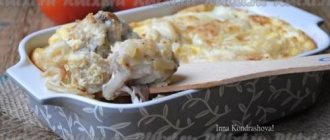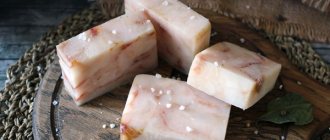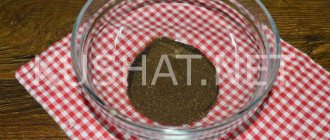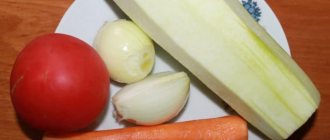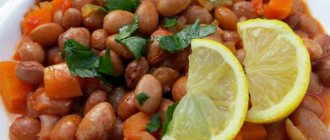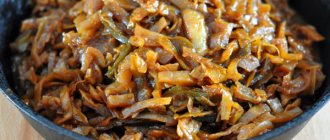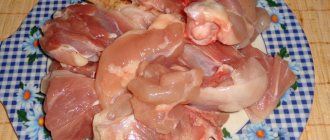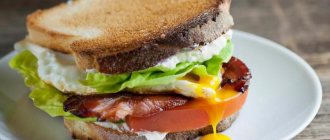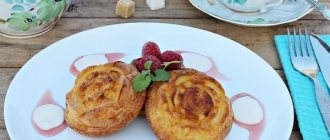Today, when supermarket shelves are bursting with variety, the inexpensive pollock fish has been consigned to undeserved oblivion. And it’s in vain! You can cook many wonderful dishes from it, even worthy of a festive table. For example, pollock in mayonnaise in the oven, under a fragrant cheese crust.
This recipe has been around for many years. Once upon a time, such fish was prepared at home, in sanatorium canteens, and in restaurants. Due to the relatively low cost, this dish can be considered an everyday dish. But it will definitely turn an ordinary family dinner into a small celebration.
Ingredients
Pollock in mayonnaise in the oven is prepared from fresh fish. In addition, we will need onions, mayonnaise, cheese. You shouldn’t strictly follow the proportions; add more if you like it more; the dish will only benefit from it. For example, to cook 0.5 kg of fish, you can use only one onion. And some people love baked onions, so why not load up on fish pieces to your heart's content?
You shouldn't skimp on cheese either. The more it is, the juicier the crust will be. As for varieties, it is worth taking hard ones that melt well. For example, “Russian”. Experimenting with cream cheese and even processed cheese can also give good results.
On average, to prepare a dish we will need:
- pollock carcasses – 5 pcs.;
- onion – 2-3 heads;
- vegetable oil (refined, odorless) – 0.3 tbsp.;
- flour – 2-3 tbsp. l.;
- mayonnaise – 200 g;
- cheese – 150-180 g;
- salt, spices to taste.
Pollock recipe in mayonnaise. Calorie, chemical composition and nutritional value.
Nutritional value and chemical composition of “pollock in mayonnaise.”
The table shows the nutritional content (calories, proteins, fats, carbohydrates, vitamins and minerals) per 100 grams of edible portion.
| Nutrient | Quantity | Norm** | % of the norm in 100 g | % of the norm in 100 kcal | 100% normal |
| Calorie content | 130.8 kcal | 1684 kcal | 7.8% | 6% | 1287 g |
| Squirrels | 6.4 g | 76 g | 8.4% | 6.4% | 1188 g |
| Fats | 9 g | 56 g | 16.1% | 12.3% | 622 g |
| Carbohydrates | 5.9 g | 219 g | 2.7% | 2.1% | 3712 g |
| Organic acids | 0.2 g | ~ | |||
| Alimentary fiber | 1 g | 20 g | 5% | 3.8% | 2000 g |
| Water | 74.9 g | 2273 g | 3.3% | 2.5% | 3035 g |
| Ash | 0.9251 g | ~ | |||
| Vitamins | |||||
| Vitamin A, RE | 40.6 mcg | 900 mcg | 4.5% | 3.4% | 2217 g |
| Retinol | 0.024 mg | ~ | |||
| alpha carotene | 0.1049 mcg | ~ | |||
| beta carotene | 0.097 mg | 5 mg | 1.9% | 1.5% | 5155 g |
| beta Cryptoxanthin | 0.3147 µg | ~ | |||
| Lutein + Zeaxanthin | 2.832 mcg | ~ | |||
| Vitamin B1, thiamine | 0.054 mg | 1.5 mg | 3.6% | 2.8% | 2778 g |
| Vitamin B2, riboflavin | 0.057 mg | 1.8 mg | 3.2% | 2.4% | 3158 g |
| Vitamin B4, choline | 19.44 mg | 500 mg | 3.9% | 3% | 2572 g |
| Vitamin B5, pantothenic | 0.087 mg | 5 mg | 1.7% | 1.3% | 5747 g |
| Vitamin B6, pyridoxine | 0.092 mg | 2 mg | 4.6% | 3.5% | 2174 g |
| Vitamin B9, folates | 8.218 mcg | 400 mcg | 2.1% | 1.6% | 4867 g |
| Vitamin B12, cobalamin | 0.049 mcg | 3 mcg | 1.6% | 1.2% | 6122 g |
| Vitamin C, ascorbic acid | 2.44 mg | 90 mg | 2.7% | 2.1% | 3689 g |
| Vitamin D, calciferol | 0.013 mcg | 10 mcg | 0.1% | 0.1% | 76923 g |
| Vitamin E, alpha tocopherol, TE | 2.149 mg | 15 mg | 14.3% | 10.9% | 698 g |
| beta tocopherol | 0.0283 mg | ~ | |||
| gamma tocopherol | 2.0422 mg | ~ | |||
| delta tocopherol | 0.5077 mg | ~ | |||
| Vitamin H, biotin | 0.803 mcg | 50 mcg | 1.6% | 1.2% | 6227 g |
| Vitamin K, phylloquinone | 20.2 mcg | 120 mcg | 16.8% | 12.8% | 594 g |
| Vitamin RR, NE | 2.2245 mg | 20 mg | 11.1% | 8.5% | 899 g |
| Niacin | 0.552 mg | ~ | |||
| Macronutrients | |||||
| Potassium, K | 178.73 mg | 2500 mg | 7.1% | 5.4% | 1399 g |
| Calcium, Ca | 36.46 mg | 1000 mg | 3.6% | 2.8% | 2743 g |
| Silicon, Si | 0.142 mg | 30 mg | 0.5% | 0.4% | 21127 g |
| Magnesium, Mg | 21.93 mg | 400 mg | 5.5% | 4.2% | 1824 |
| Sodium, Na | 95.02 mg | 1300 mg | 7.3% | 5.6% | 1368 g |
| Sera, S | 93.42 mg | 1000 mg | 9.3% | 7.1% | 1070 g |
| Phosphorus, P | 94 mg | 800 mg | 11.8% | 9% | 851 g |
| Chlorine, Cl | 75.32 mg | 2300 mg | 3.3% | 2.5% | 3054 g |
| Microelements | |||||
| Aluminium, Al | 147.6 mcg | ~ | |||
| Bor, B | 56.4 mcg | ~ | |||
| Vanadium, V | 3.2 mcg | ~ | |||
| Iron, Fe | 0.573 mg | 18 mg | 3.2% | 2.4% | 3141 g |
| Yod, I | 62.21 mcg | 150 mcg | 41.5% | 31.7% | 241 g |
| Cobalt, Co | 7.568 mcg | 10 mcg | 75.7% | 57.9% | 132 g |
| Manganese, Mn | 0.1382 mg | 2 mg | 6.9% | 5.3% | 1447 g |
| Copper, Cu | 86.23 mcg | 1000 mcg | 8.6% | 6.6% | 1160 g |
| Molybdenum, Mo | 2.08 mcg | 70 mcg | 3% | 2.3% | 3365 g |
| Nickel, Ni | 3.767 mcg | ~ | |||
| Tin, Sn | 0.18 mcg | ~ | |||
| Rubidium, Rb | 131.2 mcg | ~ | |||
| Selenium, Se | 0.487 mcg | 55 mcg | 0.9% | 0.7% | 11294 g |
| Titanium, Ti | 0.39 mcg | ~ | |||
| Fluorine, F | 313.32 mcg | 4000 mcg | 7.8% | 6% | 1277 g |
| Chromium, Cr | 23.12 mcg | 50 mcg | 46.2% | 35.3% | 216 g |
| Zinc, Zn | 0.742 mg | 12 mg | 6.2% | 4.7% | 1617 g |
| Digestible carbohydrates | |||||
| Starch and dextrins | 2.47 g | ~ | |||
| Mono- and disaccharides (sugars) | 3.1 g | max 100 g | |||
| Glucose (dextrose) | 0.4705 g | ~ | |||
| Sucrose | 1.9254 g | ~ | |||
| Fructose | 0.4586 g | ~ | |||
| Essential amino acids | 0.0788 g | ~ | |||
| Arginine* | 0.4555 g | ~ | |||
| Valin | 0.3775 g | ~ | |||
| Histidine* | 0.1684 g | ~ | |||
| Isoleucine | 0.4629 g | ~ | |||
| Leucine | 0.5487 g | ~ | |||
| Lysine | 0.7554 g | ~ | |||
| Methionine | 0.2492 g | ~ | |||
| Methionine + Cysteine | 0.3122 g | ~ | |||
| Threonine | 0.3807 g | ~ | |||
| Tryptophan | 0.0878 g | ~ | |||
| Phenylalanine | 0.2996 g | ~ | |||
| Phenylalanine+Tyrosine | 0.5508 g | ~ | |||
| Nonessential amino acids | 0.1827 g | ~ | |||
| Alanin | 0.3863 g | ~ | |||
| Aspartic acid | 0.514 g | ~ | |||
| Glycine | 0.3398 g | ~ | |||
| Glutamic acid | 0.5973 g | ~ | |||
| Proline | 0.2552 g | ~ | |||
| Serin | 0.2966 g | ~ | |||
| Tyrosine | 0.2552 g | ~ | |||
| Cysteine | 0.0658 g | ~ | |||
| Sterols (sterols) | |||||
| Cholesterol | 33.72 mg | max 300 mg | |||
| Campesterol | 1.9929 mg | ~ | |||
| Stigmasterol | 2.2027 mg | ~ | |||
| beta sitosterol | 12.3236 mg | ~ | |||
| Fatty acid | |||||
| Trans fats | 0.0059 g | max 1.9 g | |||
| monounsaturated trans fats | 0.0013 g | ~ | |||
| polyunsaturated trans fats | 0.0046 g | ~ | |||
| Saturated fatty acids | |||||
| Saturated fatty acids | 2.5 g | max 18.7 g | |||
| 14:0 Miristinovaya | 0.0058 g | ~ | |||
| 15:0 Pentadecane | 0.0005 g | ~ | |||
| 16:0 Palmitinaya | 0.5119 g | ~ | |||
| 17:0 Margarine | 0.0021 g | ~ | |||
| 18:0 Stearic | 0.2572 g | ~ | |||
| 20:0 Arakhinovaya | 0.0178 g | ~ | |||
| 22:0 Begenovaya | 0.0327 g | ~ | |||
| 24:0 Lignoceric | 0.0025 g | ~ | |||
| Monounsaturated fatty acids | 1.4583 g | min 16.8 g | 8.7% | 6.7% | |
| 16:1 Palmitoleic | 0.0192 g | ~ | |||
| 16:1 cis | 0.0028 g | ~ | |||
| 17:1 Heptadecene | 0.0012 g | ~ | |||
| 18:1 Oleic (omega-9) | 1.4084 g | ~ | |||
| 18:1 cis | 0.5109 g | ~ | |||
| 18:1 trans | 0.001 g | ~ | |||
| 20:1 Gadoleic (omega-9) | 0.008 g | ~ | |||
| 22:1 Erucic (omega-9) | 0.0016 g | ~ | |||
| 22:1 cis | 0.0014 g | ~ | |||
| 22:1 trans | 0.0002 g | ~ | |||
| Polyunsaturated fatty acids | 3.7098 g | from 11.2 to 20.6 g | 33.1% | 25.3% | |
| 18:2 Linolevaya | 3.3801 g | ~ | |||
| 18:2 trans isomer, undetermined | 0.0046 g | ~ | |||
| 18:2 mixed isomers | 0.0112 g | ~ | |||
| 18:2 Omega-6, cis, cis | 1.1906 | ~ | |||
| 18:2 Conjugated linoleic acid | 0.0015 g | ~ | |||
| 18:3 Linolenic | 0.1671 g | ~ | |||
| 18:3 Omega-3, alpha-linolenic | 0.1592 g | ~ | |||
| 18:3 Omega-6, gamma-linolenic | 0.0038 g | ~ | |||
| 20:2 Eicosadiene, Omega-6, cis, cis | 0.001 g | ~ | |||
| 20:4 Arachidonic | 0.014 g | ~ | |||
| Omega-3 fatty acids | 0.2 g | from 0.9 to 3.7 g | 22.2% | 17% | |
| 22:4 Docosatetraenoic acid, Omega-6 | 0.0736 g | ~ | |||
| 22:6 Docosahexaenoic acid (DHA), Omega-3 | 0.0779 g | ~ | |||
| Omega-6 fatty acids | 1.2 g | from 4.7 to 16.8 g | 25.5% | 19.5% |
The energy value of pollock in mayonnaise is 130.8 kcal.
Primary Source: Created in the application by the user. Read more.
** This table shows the average levels of vitamins and minerals for an adult. If you want to know the norms taking into account your gender, age and other factors, then use the “My Healthy Diet” application.
Dishes
To prepare pollock with cheese and mayonnaise, you need dishes with high sides. A cast iron wok or deco, a ceramic container, or a casserole dish are perfect. It is advisable to select dishes of such a size that the pieces of fish can be placed tightly together in one layer.
If the necessary vessel is not available on the farm, you can cook such fish on a regular baking sheet. Only in this case, you should not place the ingredients too close to the edges, otherwise they will simply fall off and burn.
Pollock in the oven with mayonnaise and mushrooms, under a cheese cap
Ingredients:
Forest agaric mushrooms or fresh small champignons – 250 gr.;
Bitter onions - two heads;
Three large tomatoes;
100 grams of hard cheese;
Thin mayonnaise.
Cooking method:
1. Defrost the fish. We scrape the scales with a knife and cut off the fins. Gutted and cut into fillets. After washing, cut into pieces up to five centimeters wide.
2. Place the pollock pieces in a bowl and add a little salt. After stirring, set the bowl of fish aside for a while.
3. Finely chop the onion, cut the mushrooms into medium-sized slices or strips. Place the onion in a frying pan heated with vegetable oil. Stirring, fry until lightly browned. Add mushrooms and continue frying until done. At the end, add a little salt and season the fried mushrooms with ground pepper.
4. Remove the peel from the tomatoes. Cut the tomatoes in half and cut into thin slices. Grind the cheese on a coarse grater.
5. Line the bottom of the baking sheet with parchment and place the pieces of fish tightly together. Distribute the mushroom fry evenly on top. We distribute tomato slices over it and grease them with mayonnaise.
6. Place the baking sheet with the fish in a hot (190 degrees) oven. After ten minutes, take it out, sprinkle with cheese shavings and place back for another 10 minutes.
Preparation
Cut the fish into pieces about 3 cm wide. Roll the pieces in flour, fry in heated oil until half cooked.
Sauté the onion in oil until golden brown. Now put the pieces of fish on the bottom of the mold, sprinkle onions on top and add a little boiled water. This is necessary for the meat to steam.
Pour mayonnaise over the onion, spreading it evenly with a silicone spatula so that it covers the entire surface of the dish. Place in the oven to bake.
Don't sprinkle cheese on it right away. The time required for its melting is very short. It will simply not be enough to bake onions and fish. As a result, either the cheese cap will burn, or the main ingredients will not be baked. Therefore, while pollock is being cooked in mayonnaise in the oven, grate the cheese on a coarse grater and add it about 7 minutes before the end of the process.
A word about spices
As for spices, you can add them directly to the fish pieces. But it’s better to mix it with water, which we pour into the dish at the very beginning. Black and allspice, oregano, and marjoram work well here. Paprika will give the dish a sweetish note and make its color more expressive. Asafoetida goes very well with fish. You can also sprinkle pollock with mayonnaise in the oven with fresh herbs after cooking.
New notes
Those who have already gotten the hang of cooking this dish often experiment with the basic recipe. For example, they cook not pieces, but pollock fillets in mayonnaise in the oven. This method is more labor-intensive, but the result is simply excellent. Although there are few bones in pollock, you can also remove the spine so that there are none left at all.
You can diversify the recipe by introducing additional experiments. For example, add a layer of fried mushrooms. In summer, you can place pieces of fish on a bed of baked vegetables (squash, eggplant, zucchini). Stewed carrots go well with the taste of pollock. And diced bell peppers, especially of different colors, will not only add flavor, but also decorate the dish.
You can experiment with sauces too. For example, replace part of the mayonnaise with sour cream and add chopped herbs. This sauce is more delicate in texture, and the taste is rich and expressive. Soy sauce is also suitable for this dish, but when using it you need to be careful with salt, because it is already quite salty. Add a spoonful of tartar, paprika sauce, or any other favorite sauce to the mayonnaise.
How to submit?
Pollock stewed with onions and other ingredients must be presented to the table along with some kind of side dish (mashed potatoes, boiled buckwheat, etc.) and fresh herbs.
Pollock is one of the most popular types of sea fish. Affordable price is not the main indicator of popularity; its white meat has a neutral taste and goes well with almost all foods and vegetables, which allows you to expand the fish menu with a variety of dishes.
Mayonnaise benefits the taste of fish. Pollock dishes with mayonnaise are always juicy and nutritious. In addition, they are easy to prepare, which does not require much time. In just an hour, even the most inexperienced housewife can feed her family well. When preparing a festive table, such dishes will not only add variety to it, but will also decorate it, because this is not just fried fish.
Pollock in mayonnaise can be stewed in a frying pan, baked in the oven on a baking sheet or in pots. There are many recipes for preparing such fish dishes for multicookers. Try at least one, and you will certainly want to try others.
Serving
Pollock in the oven with mayonnaise and onions should be served in the same container in which the dish was baked in the oven. It is convenient to place it on plates using a wooden spatula or spoon, after cutting through the cheese cap.
This dish can be garnished with mashed potatoes, boiled rice, and buckwheat porridge. It also goes well with pasta, especially shells, which hold the gravy well. Can be served with baked pollock and spaghetti.
Homemade pickles or a salad of fresh seasonal vegetables are a great addition to the dish. Don't forget about fresh herbs: parsley, dill, cilantro, basil, young garlic and onions.
Drinks that go well with this dish include tomato juice, homemade kvass, milk, ayran and any fermented milk drinks.

